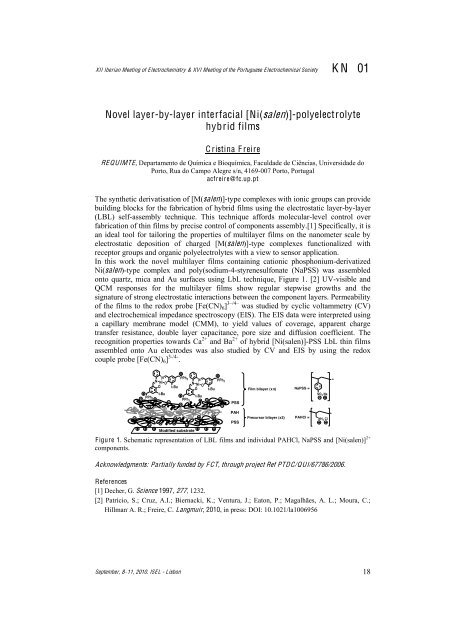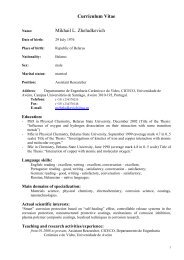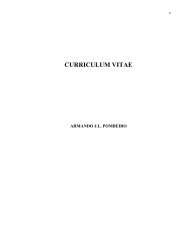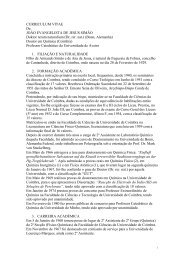XII Iberian Meeting of Electrochemistry XVI Meeting of the ...
XII Iberian Meeting of Electrochemistry XVI Meeting of the ...
XII Iberian Meeting of Electrochemistry XVI Meeting of the ...
Create successful ePaper yourself
Turn your PDF publications into a flip-book with our unique Google optimized e-Paper software.
<strong>XII</strong> <strong>Iberian</strong> <strong>Meeting</strong> <strong>of</strong> <strong>Electrochemistry</strong> & <strong>XVI</strong> <strong>Meeting</strong> <strong>of</strong> <strong>the</strong> Portuguese Electrochemical Society K N 01<br />
Novel layer-by-layer interfacial [Ni(salen)]-polyelectrolyte<br />
hybrid films<br />
C ristina F reire<br />
REQUIMTE, Departamento de Química e Bioquímica, Faculdade de Ciências, Universidade do<br />
Porto, Rua do Campo Alegre s/n, 4169-007 Porto, Portugal<br />
acfreire@fc.up.pt<br />
The syn<strong>the</strong>tic derivatisation <strong>of</strong> [M(salen)]-type complexes with ionic groups can provide<br />
building blocks for <strong>the</strong> fabrication <strong>of</strong> hybrid films using <strong>the</strong> electrostatic layer-by-layer<br />
(LBL) self-assembly technique. This technique affords molecular-level control over<br />
fabrication <strong>of</strong> thin films by precise control <strong>of</strong> components assembly.[1] Specifically, it is<br />
an ideal tool for tailoring <strong>the</strong> properties <strong>of</strong> multilayer films on <strong>the</strong> nanometer scale by<br />
electrostatic deposition <strong>of</strong> charged [M(salen)]-type complexes functionalized with<br />
receptor groups and organic polyelectrolytes with a view to sensor application.<br />
In this work <strong>the</strong> novel multilayer films containing cationic phosphonium-derivatized<br />
Ni(salen)-type complex and poly(sodium-4-styrenesulfonate (NaPSS) was assembled<br />
onto quartz, mica and Au surfaces using LbL technique, Figure 1. [2] UV-visible and<br />
QCM responses for <strong>the</strong> multilayer films show regular stepwise growths and <strong>the</strong><br />
signature <strong>of</strong> strong electrostatic interactions between <strong>the</strong> component layers. Permeability<br />
<strong>of</strong> <strong>the</strong> films to <strong>the</strong> redox probe [Fe(CN) 6 ] 3/4 was studied by cyclic voltammetry (CV)<br />
and electrochemical impedance spectroscopy (EIS). The EIS data were interpreted using<br />
a capillary membrane model (CMM), to yield values <strong>of</strong> coverage, apparent charge<br />
transfer resistance, double layer capacitance, pore size and diffusion coefficient. The<br />
recognition properties towards Ca 2+ and Ba 2+ <strong>of</strong> hybrid [Ni(salen)]-PSS LbL thin films<br />
assembled onto Au electrodes was also studied by CV and EIS by using <strong>the</strong> redox<br />
couple probe [Fe(CN) 6 ] 3-/4- .<br />
N<br />
N<br />
Ni O<br />
O<br />
t-Bu<br />
PPh 3<br />
PPh 3<br />
N<br />
N<br />
Ni<br />
t-Bu<br />
O<br />
O<br />
t-Bu<br />
PPh 3<br />
t-Bu<br />
PPh 3<br />
PSS<br />
Film bilayer (xn)<br />
NaPSS =<br />
SO 3 Na<br />
*<br />
PAH<br />
PSS<br />
Precursor bilayer (x2)<br />
PAHCl =<br />
NH 3 Cl<br />
*<br />
Modified substrate<br />
Figure 1. Schematic representation <strong>of</strong> LBL films and individual PAHCl, NaPSS and [Ni(salen)] 2+<br />
components.<br />
Acknowledgments: Partially funded by F CT, through project Ref PTDC/QUI/67786/2006.<br />
References<br />
[1] Decher, G. Science 1997, 277, 1232.<br />
[2] Patrício, S.; Cruz, A.I.; Biernacki, K.; Ventura, J.; Eaton, P.; Magalhães, A. L.; Moura, C.;<br />
Hillman , A. R.; Freire, C. Langmuir, 2010, in press: DOI: 10.1021/la1006956<br />
September, 811, 2010. ISEL - Lisbon 18








